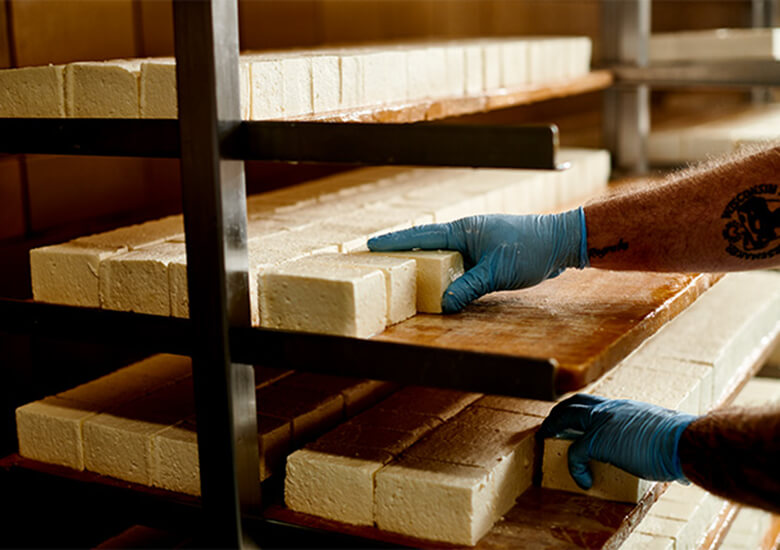Cheese ages like fine wine and your favorite pair of jeans: that is to say, it ages well and in all the best ways. What was once a milky, mild, and smooth soft cheese becomes firm, caramelized, and nutty. A young cheddar and an aged cheddar may as well be two completely different cheeses.
But aging cheese is more complex than it sounds. Skilled cheesemakers in Wisconsin and beyond have precise conditions under which their cheese is aged. To learn all about the cheese aging process and the best, aged Wisconsin Cheeses to try, look no further.
Why is cheese aged?

Without aging, many of our favorite cheeses simply wouldn’t exist. Aging is what helps develop unique and interesting flavors that cheesemakers couldn't get any other way.
Have you ever taken a bite out of an aged cheddar and marveled at the delightfully rich, sharp flavor? That flavor is just one of the countless delicious possibilities that cheesemakers can bring about through the aging process.
Cheesemakers can shape the aging process by introducing different bacterial or mold cultures to the cheese and by manipulating the storage environment to create certain conditions that speed up or slow down the progress—it’s a tasty intersection of art and science!
What happens to cheese as it ages?
In a nutshell, the aging process intensifies the flavor and changes the texture of cheese. As cheese ages, it loses moisture while enzymes and microbes continue developing within the cheese.
These friendly bacteria help transform lactose into lactic acid and build other amino acids to give aged cheese its unmistakable taste. Aging is what helps give cheeses like parmesan their signature crunchy crystals, which are made up of an amino acid called tyrosine.
Turns out science can be pretty delicious!
What cheeses are aged?

Almost any cheese can be aged, but it’s more common for some rather than others. Here’s a list of cheeses that are most commonly aged:
Parmesan
Asiago
Blue
Cheddar
Gouda
Gorgonzola
Alpine-style
Brick
Not all cheeses are aged, and some cheeses, like mozzarella, are best enjoyed fresh. The younger and fresher the cheese, the milder and softer it is. If you’re planning a cheese board, we always suggest having a blend of young and aged cheeses so there’s something for everyone.
How cheese is aged

The process of aging cheese is highly precise and scientific. Cheesemakers utilize the following different cheese aging techniques to achieve different flavors, textures, and aromas. The best part? Every single one is delicious.
Surface-ripening
As the name suggests, this aging technique is when cheese is aged from the surface and down through to the past of the cheese itself. Cheesemakers can encourage this by rubbing the cheese with washes, brine, or introducing helpful microorganisms to the surface.
Surface-ripened cheeses are often known for their unique and often tasty rinds. (That’s right—most rinds are safe to eat. Learn all about them in our Cheese Rinds 101 guide.) One of Wisconsin’s most beloved examples of a surface-ripened cheese is Uplands' Rush Creek Reserve.
Interior Ripening
Then there is the opposite approach: interior ripening. With this technique, cheese is ripened from the inside outward. Cheesemakers will often cover the cheese in wax or wrap it in bandages, usually cheese cloth or muslin, to help prevent the surface from aging.
One shining example of a stellar cheese that’s interior ripened is swiss. By wrapping the exterior of a wheel of swiss, cheesemakers create a rindless and smooth cheese that’s softer the closer you get to the center.
Temperature and humidity
When it comes to aging cheese, few factors are as important as temperature and humidity. Most cheeses thrive in a narrow range of humidity and temperature. Although the exact numbers vary, most cheeses appreciate high humidity and temperatures around 50 degrees Fahrenheit for the best results.
It’s crucial for cheesemakers to carefully monitor how quickly their cheese is losing moisture during the aging process.
Too much or too little can ruin the rind or interior texture of the cheese. Wisconsin’s Master Cheesemakers often spend years fine-tuning the process of making a single variety of cheese, and a significant portion of this effort goes to deciding how to manipulate temperature and humidity during the aging process.
Environment

In addition to all of the above, cheesemakers can make subtle tweaks to the cheese aging environment that have big impacts on the final flavor of their cheese. For example, Bleu Mont Dairy’s award-winning Bandaged Cheddar is aged on spruce wood.
Why spruce boards? Over the one to two-year aging process, the spruce wood’s nutty and slightly sweet aroma naturally seeps into the cheese, yielding delicious results. Spruce boards also have a nice give and take in terms of that ever-important humidity factor. The possibilities don’t just end here, though. Cheesemakers use everything from oak planks to pine and even birch wood!
As you may gather, the average Cheese Lover probably doesn’t have the right tools or environment available to properly age cheese. If you ever, somehow, find yourself with leftover cheese, though, we’ve covered everything you need to know about cheese storage here.
A taste of time
Ready to explore Wisconsin’s endless varieties of aged cheese by planning your own cheese tasting? You can get award-winning Wisconsin Cheese and cheese gift baskets delivered right to your door with our continuously updated list of cheesemakers and retailers that allow you to order cheese online. Award-winning Wisconsin Cheese is just a click away.
If you want to cook a full meal, try our selection of over 400 handcrafted recipes featuring Wisconsin Cheese. Share your creation with us on Instagram or Facebook and become part of the largest cheese community in the world!
